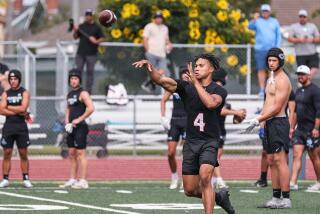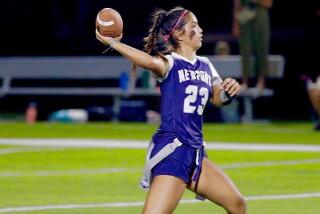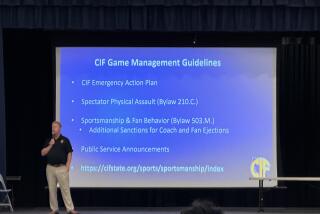Method That Sets Physical Criteria for Participation in Athletic Events Has EnduredDespite Criticism : City Section Divided Over Exponent System
The Exponent System.
Sounds impressive, but what is it?
It is a method used by the City Section that supposedly provides playing opportunities below the varsity level for high school athletes based on their height, weight and age.
In simple terms, it classifies youngsters so that little Jimmy, a 5-foot, 2-inch, 110-pound running back, doesn’t get his head pounded into his chest cavity by a defensive tackle who is a foot taller and outweighs him by 150 pounds.
A more sophisticated explanation of the complex--and controversial--Exponent System is provided by Hal Harkness, director of interscholastic athletics for the Los Angeles Unified School District.
“There is a table that takes into effect any variable of three coefficients--height, weight and age. Each is established a certain value. You compute the set of given factors on the table by adding up the total sum and seeing where it compares on the table.”
In essence, each athlete’s weight, height and age are added and assigned a value. If the total reaches or exceeds 90 exponents, the athlete plays varsity or junior varsity ball. If the total falls between 84-90, he plays on a separate B football or B basketball team. Anything less than 84, the athlete floats to C level.
A 15-year-old athlete, for instance, who weighs 136 pounds and stands 5-8 would total 85 on the scale and qualify for the B team.
“It’s designed to minimize size inequity,” Harkness said. “It divides kids of varying sizes.”
But, recently, the Exponent System also has polarized coaches, players, parents and administrators. Some say it provides a measure of safety and opportunity for smallish students who want to participate in sports. Others say providing the chance for small students to play football is like providing tone-deaf students a chance to sing in the school choir. Still others claim the 50-year-old system not only is outdated but out of step with the rest of the state and country. The City is the only section in California still using exponents to group athletes in football, basketball and track.
Every other section in the free world has switched to grade-level classifications, which include freshman, sophomore and varsity teams.
“I lean toward the frosh-soph system,” said Wally Meinke, who has coached the B football team at Canoga Park for two years. “With the B system, you might get an 18-year old playing against 14-year-old kids. They’re the same size, but there’s a maturity difference.
“The B system is outdated. You might have a young man who is 14 years of age--a big kid--who isn’t allowed to play varsity football.”
Such was the case of Jason Keiderling, a 6-5, 215-pound defensive tackle at Reseda. Even though he was only 14 when his exponents were tallied in September, Keiderling tilted the scale out of whack with a total of 97. A year ago, as a freshman, he rolled up a sum of 95 exponents.
Those numbers precluded Keiderling from playing B football in the City, but the scenario was further complicated by a state rule barring any high school athlete under age 15 from competing in a contact sport at the varsity level. He could have played junior varsity football at Reseda, but the school has none.
As a result, Keiderling--who has been allowed to participate in Reseda practices--has been shut out from playing in games at any level. Raymond Keiderling, Jason’s father, appealed to Harkness in July but was given little hope for a rule change. After meeting with members of the L. A. school board in September, Jason Keiderling was told he must comply with the Exponent System. That meant waiting until he was 15 to play varsity or losing 60 pounds to play on the B team.
“He was caught with no place to go,” Harkness said.
He had been Exed.
For his part, Keiderling said: “I lost two years of game experience because of it. I think they should have some sort of waiver of the rules. I feel I was cheated. I don’t understand that Exponent System thing.”
Nevertheless, he outlasted it. After his 15th birthday on Dec. 3, Keiderling played on special teams in the Regents’ playoff wins over South Gate and Huntington Park. “I’m just happy to be playing,” he said. “What’s past is past.”
Whether the Exponent System itself will become a thing of the past remains uncertain. Richard Pendergast, who has coached B football for more than 20 years and currently coaches at Chatsworth, said the idea of scrapping exponents and falling in line with the rest of the state becomes a “hot topic” among City coaches, administrators and community representatives every “two or three years.”
“I don’t know what’s going to happen,” he said. “There are a lot of people in the Harbor and East Side areas who want to keep the system. There are a lot of smaller Oriental and Hispanic kids in those areas.
“But the varsity coaches want to get rid of B football so they can better control the whole program.”
While Harkness admitted that “a lot of people want to see it done away with,” in favor of the grade-level classification, he also said the system probably will remain intact--for now. “I know of no major thrust for change on the horizon,” he said.
The freshman-sophomore-varsity format would alleviate some problems but would create another, according to Pendergast. “The schools that are three-year schools then have a disadvantage to the four-year schools because they would have more frosh-soph players.”
Already, under the current setup, inequity in numbers of players has caused concern among many B football coaches--some have 30 players, some 50. But B teams in general have suffered an across-the-board loss of players over the past 10 years. Attendance at B games also has dropped. “We probably get around 20% of the crowd the varsity gets when we play a doubleheader,” Pendergast said. All of which brings up obvious questions then: Is B football dead? If so, does anybody care?
“I don’t think the stigma of playing B football has made students shy away from playing,” Harkness said. “I don’t think it’s in bad condition, no more so than any program. We’re probably averaging 35-40 players on B teams, but if you look at varsity teams, they’re down, too. I haven’t noticed that B teams have gotten to the point where they are frowned upon.”
Nonetheless, not being frowned upon is a long way from being a big hit. How much interest can be generated by the less-than-scintillating prospects of watching two 5-1, 135-pound linemen bounce off each other? Nowadays, relatives usually are the only interested parties.
“We always had pretty big crowds for B games,” said Jack McCaffrey, a former Taft B coach who retired eight years ago. “Now, they don’t even have crowds for varsity games.
“But I still think B football is good. It gives the smaller kid a chance.”
Occasionally, it gives a small kid a big chance. Eric Yarber, who played B football at Crenshaw High because he was undersized, now stands 5-8, weighs 153 pounds and plays for the Washington Redskins. Yarber, who earned All-American honors at Valley College, said he was upset when coaches decided he should play on Crenshaw’s B team instead of the varsity. Looking back, though, he said playing B football was the right move. “I was thinking my heart alone would get me by,” he said. “But heart wasn’t going to stop broken bones. It just gave me more incentive to work harder.”
Still, Harkness said the number of spectators who show up for B games and paving a road to the NFL have nothing to do with the reasons for continuing B football.
“The bottom line is these programs are provided with interest in getting participation. It’s there to give smaller students an opportunity to play.”
And, perhaps, an opportunity to live to tell about it.
More to Read
Get our high school sports newsletter
Prep Rally is devoted to the SoCal high school sports experience, bringing you scores, stories and a behind-the-scenes look at what makes prep sports so popular.
You may occasionally receive promotional content from the Los Angeles Times.






